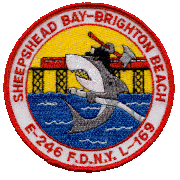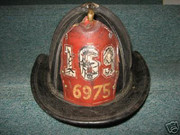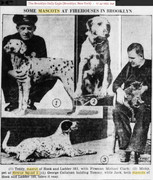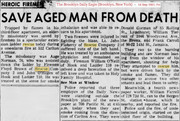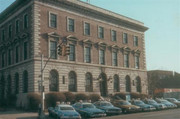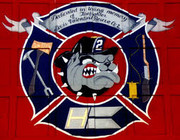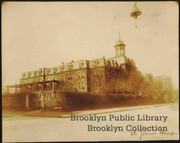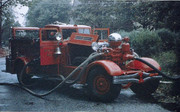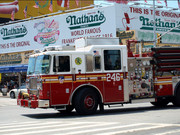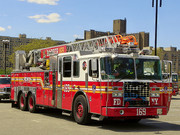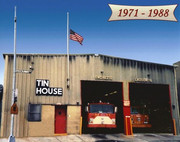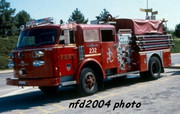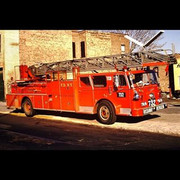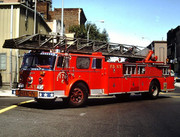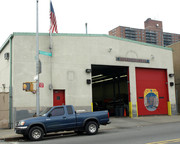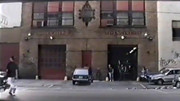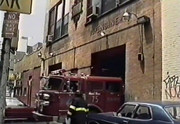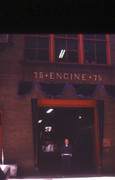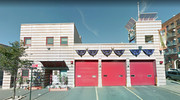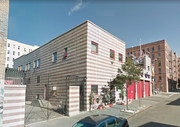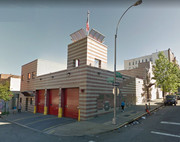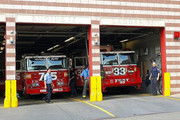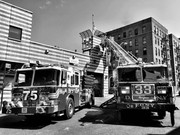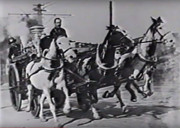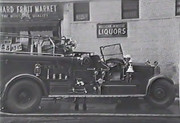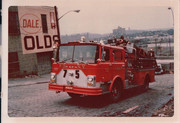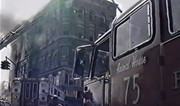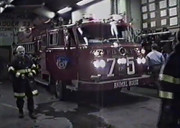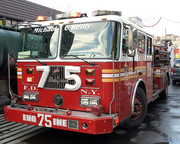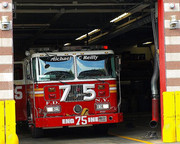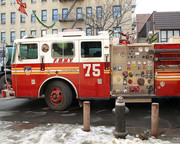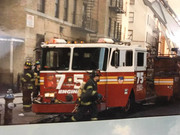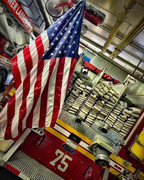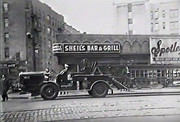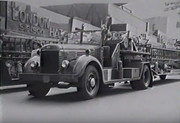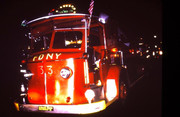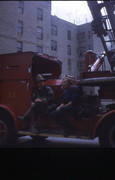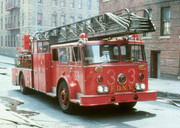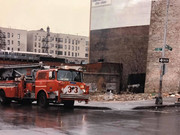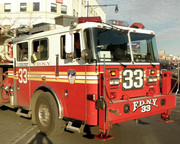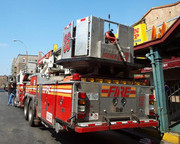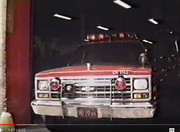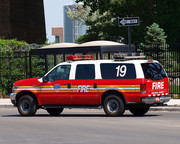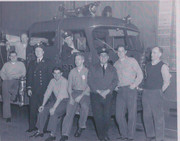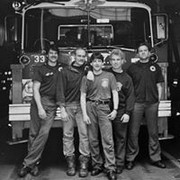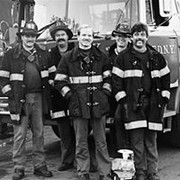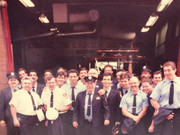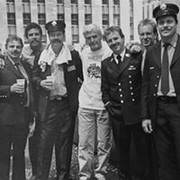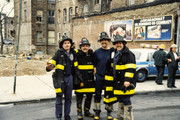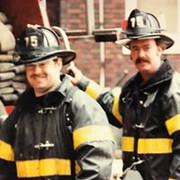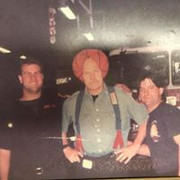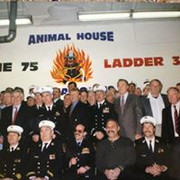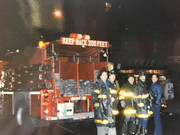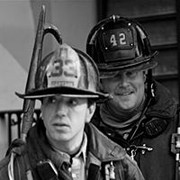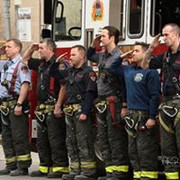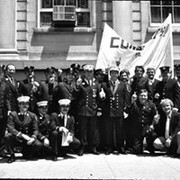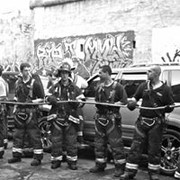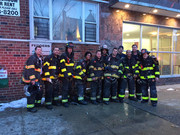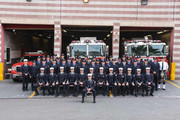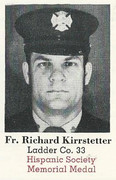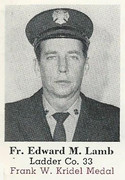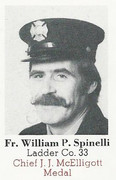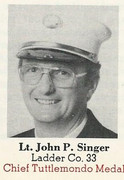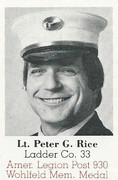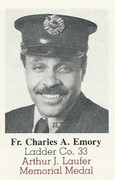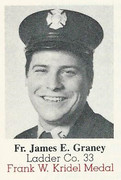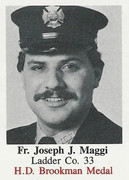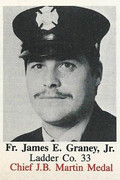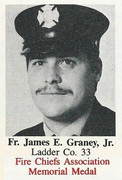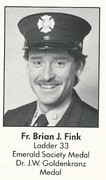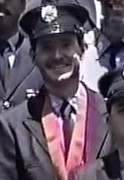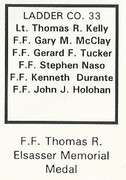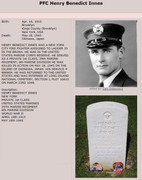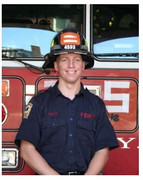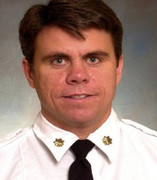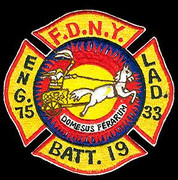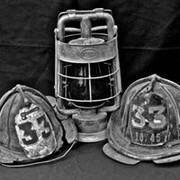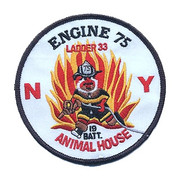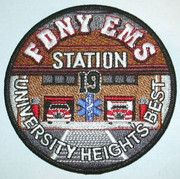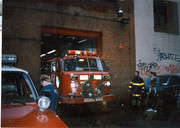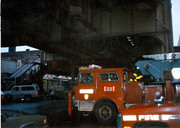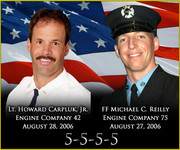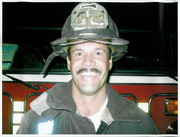Engine 246/Engine 327/Ladder 169/Relay Hose Wagon 105 - original firehouse - 2731 E 23rd Street - Sheepshead Bay, Brooklyn

____________________________________
SHEEPSHEAD BAY AND 100 YEARS FIRE SERVICE By Mike Boucher S.I. CO
Engine 246 and Ladder 169 have been responding to fires in the Sheepshead Bay area of Brooklyn since December 9, 1895. One hundred years ago this area was part of the City of Brooklyn, the fourth largest city in America, and not New York City. The fire trucks were not even painted red but, two tone green. Brooklyn placed Engine 46 and Ladder 17 in service in the former quarters of the Sheepshead Bay Volunteer Fire Department.
The Sheepshead Volunteer Fire Department was organized around February of 1889 with Friendship Ladder 1. Before the volunteers were disbanded on December 9, the Department had grown to one steamer, one hose company, one hand engine, and one ladder companies. All four companies were located at 2728 East 23rd Street, then known as Anthony Place and then renamed to Delamere Street before becoming East 23rd Street.
Engines 44, 45, 46, 54 and Ladders 16 and 17 replaced all of the volunteer companies in the late Town of Gravesend. The towns of New Utrecht, Gravesend, and Flatlands were annexed into the City of Brooklyn on May 3, 1894. This annexation more than double the size of Brooklyn. When annexed, the fire protection would be provided by the volunteers until the City's paid force could be expanded into the newly annexed area. All of the expenses to operate the volunteers would be paid for by the City.
Engine 46 was placed in service with eight men with a used 1893 Silby 4th size (300-200 gpm) steamer and a new P.J. Barrett hose wagon. Ladder 17 received a new Gleason & Baily, 50 foot aerial and was manned by ten men. Members of the Friendship fire companies were given preference in hiring for the new companies. The steamer and hose wagon were both pulled by two horses and came from the town of Gravesend, The ladder was pulled by a three horse hitch and was purchased by the City of Brooklyn. Both companies were located in the former quarters of the Friendship companies on the west side of East 23rd Street. The rent for the two story building was $500.00 a year.
Engine 46 and Ladder 17 would belong to the Brooklyn Fire Department only until January 1, 1898. On that day, the Cities of Brooklyn, New York, and parts of Queens and Bronx Counties, along with Staten Island merged into the Greater City of New York and its five boroughs. On January 28, both Engine 46 and Ladder 17 became part of Brooklyn and Queens Fire Division of the New York City Fire Department.
Ladder 17 was disbanded on April 15, 1898 as a single unit and combined with Engine 46 to form Combination Engine 46. The Captain of the ladder was replaced by a Lieutenant and Engine 46 was painted on the side of the ladder truck. Both companies would respond as Engine 46 on most runs, but the truck could respond as a single unit and would be called Ladder 46. The total number of runs between the two would be reported under Engine 46.
To avoid confusion with the Manhattan and Bronx companies, the Brooklyn and Queens companies were renumber on October 1, 1899. Combination Engine 46 became Combination Engine 146. Combination Engine 146 would be renumber again on January 1, 1913 to Combination Engine 246 due to the increase of new companies being placed into service in Brooklyn and Queens.
When Brooklyn placed these two companies in service it was with the intention of building new quarters for both Engine 46 and Engine 45 at the earliest possible date. Both of these houses were not built with living quarters in them. The Fire Department had to put several thousands of dollars into these houses to fix them for the paid members.
With the merger of New York and Brooklyn, new quarters were put off for the time being. In 1902 money was allotted for the construction of new houses in Brooklyn and plans were drawn up. New quarters were built for Engines 224, 231, 245, 246 and several other houses were remodeled.
Combination Engine 146 moved into a new three bay, two story fire house on December 22, 1904. The house was located at 2731 East 23rd Street. The fire house measured 73 feet in the front and 84' feet deep. The building was built on a lot that was purchased by the late town of Gravesend on August 23, 1878 from James B, and Anna Voorhies for a total of $750.00. The lot measured 75 feet by 196 feet. To build the fire house an old school building was torn down. The house cost $73,072.00 to build.
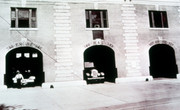
With the vast area that Engine 146 had to cover, a second section was placed in service on December 22, 1904. The second section would respond with the first section on most call. Other times it would stay in quarters and respond to another fire which wasn't to often. The first year in service all three rigs responded to only thirty four runs.
Motorization came to East 23rd Street in 1920. The second section received a used 1905 W. S. Nott 2nd size (700-900 gpm) steamer with a Christie front end drive. The first section received a new 1921 American LaFrance 700 gpm pumper. In 1921 the ladder received a new Pirsch/White combination chemical & city service ladder truck. The hose wagon was replaced with a new 1922 Mack/Boyd hose wagon on December 21, 1922.
On October 16, 1929, General Order Number 59 would place Ladder 169 in service with twelve members effective two days later. After thirty-one years of service and no identity, Brooklyn Ladder 17 was given one, Ladder 169. Most of the members that were assigned to the ladder portion of Engine 246 were assigned to Ladder 169. A lieutenant was still in charge of the ladder and not a captain. The company received a used 1924 American LaFrance 75' aerial from Ladder 123.
Engine Company 246 was discontinued as a Double Combination Company and reorganized as a Double Engine Company with two engines and one hose wagon. The second section of 246 was renumber on August 16, 1939 to Engine 327.
Because of World War 2 and the Germans bombing England, five Hose Wagons were placed in service through out the City. Relay Hose Wagon 105 was placed in service at Engine 246's quarters on December 26, 1942 and disbanded on May 15, 1945. These wagons were older aerial ladder trucks that the shops converted by removing the ladders and converting it to carry 3,000 feet of 31/2" hose.
The block of East 23rd Street where the firehouse sat became a dead end street once the Belt Parkway was built in the early 1940's. The response time to Sheepshead Bay was reduced. The company had to travel away from Sheepshead Bay to cross over the Parkway. In the Capital Budget for 1944 Engine 327 and a new ladder company were going to be placed in a new house around 20th Avenue and East 64th Street. The condition of the 1904 fire house was beginning to show its age. These three factors, dead end street, Engine 327 moving and the age of the building sealed the fate of the old fire house.
The Fire Department started looking for a new location as early as November 1943. A lot was picked out on the northwest corner of Neptune Avenue and West 11th Street and given to the Fire Department on October 20, 1955. This location would cut the time responding to Sheepshead Bay and Brighton Beach. Plans for the new house were drawn up in 1950 by the Department of Public Works. The house was going to be two stories with a four story hose tower in the front and to the right of the apparatus door.
Early in 1958 it was learned that Neptune Avenue was going to widen by forty feet on the north side of the street, thus the lot would be to small for the fire house. A smaller lot, owned by the City, on East 11th Street and Banner Avenue was chosen.
Because of the move in location the cost of the house went from $293,057.00 to $360,326.00. Back in 1944 the estimated cost for the building was $115,000.00. Since the lot was smaller the hose tower was cut out of the plans.
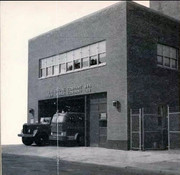 On July 16, 1960, twenty three years after starting the process of building a house, Engine 246 and Ladder 169 moved into their new firehouse at 2732 East 11th Street.
On July 16, 1960, twenty three years after starting the process of building a house, Engine 246 and Ladder 169 moved into their new firehouse at 2732 East 11th Street. Engine 327, slated for new quarters in 1944, was disbanded on that day. Since moving here only one other company has responded from these door and that was Battalion 43 from July 24, 1968 until August 7, 1971. The Battalion moved from Engine 245's old quarters when it was torn down for a new station.
Two member of each company have received medals for bravery. The first members to received a medal was Firefighter 1st grade Peter S. Viola of Ladder 169. He was awarded the Steuben medal for rescuing a woman from a fire at 8 Brighton 15th Street on February 23, 1972. The next two members were both from the engine in 1985. The first was Lt. John R. Fullam for rescuing an unconscious firefighter from a 2nd alarm fire at 2335 Coney Island Avenue on January 16, 1985. He received the Lt. Robert R. Dolney Medal. The Uniformed Fire Officers Association Medal was awarded to Captain Patrick J. Boylan of Engine 246 for a rescue at 1816 Voohries Avenue on December 16, 1985. The last member to received a medal was Firefighter Oscar Thomason of Ladder 169. He received the Emerald Society Medal for rescuing a elderly lady from 3130 Brighton 6th Street on March 28, 1988.
One member of Engine 246 has paid the supreme sacrifice by giving his life. Lieutenant Harry M. Maloney was partially paralyzed after the engine backed over him at a grass fire at Ave. "X" and East 23rd Street. The accident happen on March 25, 1940, two months after taking the lieutenants test. On January 1, 1945 Firefighter Maloney was promoted to a lieutenant. He died of complication from his injuries on August 9, 1948. He joined the Fire Department on January 1, 1937. He left a wife and a daughter.
After one hundred years of service, the Brooklyn Fire Department, horses, green rigs, a second section, and three different locations Engine 246 and Ladder 169 have been faithfully serving the people of Sheepshead Bay and Brighton Beach. They have been there for fires, floods and other emergencies and will continue to serve the people of New York City.
____________________________________
ROLL OF HONOR:
STEUBEN ASSOCIATION MEDAL
Awarded to Fireman 1st Grade Peter S. Viola, Ladder Co. 169, for heroic work, at Unusual Personal Risk, in effecting the rescue of a woman from a fire at premises 8 Brighton 15th Street, Brooklyn, Box 2-2 3685, 0632 hrs., February 23, 1972. Also award $100.00 Saving Bond by the Steuben Association.
LIEUTENANT ROBERT R. DOLNEY MEDAL
Awarded to Lieutenant John R. Fullam, of Engine 246, for heroic actions at Unusual Personal Risk in effecting the rescue of an unconscious F.D.N.Y. Lieutenant from a Second Alarm fire at 2335 Coney Island Avenue, Brooklyn, on January 16, 1985, Box 3343, at 0854 hours. Also awarded $500, to be presented by Dominick Della Rocca.
UNIFORMED FIRE OFFICERS ASSOCIATION MEDAL
Awarded to Captain Patrick J. Boylan of Engine Company 246 for his selfless and heroic actions at Unusual Personnel Risk in the rescue of an unconscious baby boy from an "All Hands" fire at 1816 Voohries Avenue, Brooklyn Box 3287, on December 16, 1985, at 0831 hours. Awarded $350.00 cash.
EMERALD SOCIETY PIPES & DRUMS MEDAL
Awarded to Firefighter 1st grade Oscar C. Thompson of Ladder Company 169 for his great initiative and perseverance in attempting to rescue an elderly woman from a fire at 3130 Brighton 6th Street, Brooklyn, Box 3657, on March 28, 1988, at 2119 hours. Also awarded $400.00 in Savings Bonds from several persons.
EDITH B. GOLDMAN MEDAL
Awarded to Lieutenant Lawrence W. Weston of Ladder 169 for operating under extrme personal risk in rescuing a nine year old child and adult male from a fire at 59 Brighton 10 Court, Brooklyn, Box 3651, on August 14, 1994.
FRANK W. KRIDEL MEDAL
Awarded to Lieutenant John Rementeria, Engine 246, in 1998 - addition to original list.
MAYOR FIORELLO H. LAGUARDIA MEDAL
Awarded TO FF John V. Kroczynski, Ladder 169, in 2005 - addition to original list.
____________________________________
This is the Department Order listing Lt. Harry M. Maloney death. He was injured while operating at a grass fire at Avenue "X" and Coney Island Avenue.
HEADQUARTERS FIRE DEPARTMENT CITY OF NEW YORK
SPECIAL ORDER No 136 NEW YORK, August 11, 1948
I With regret, the death of Lieutenant Harry M. Maloney, of Engine Co. 246, which occurred at 5.30 A. M., August 9, 1948, from injuries sustained in the performance of duty while operating at Signal Station 5-3297-246, Brooklyn, received at 8.42 P. M., March 25, 1940, is hereby announced to the Department.
The heartfelt sympathy of the entire Department goes out to the family, relatives and friends of the deceased in the midst of the great loss which they and the Department have sustained.
The funeral will take place from his late residence, 3617 Glenwood Road, Borough of Brooklyn, at 9.30 A. M., Friday, August 13, 1948. Interment at St. Charles Cemetery, Farmingdale, L.I.
THE FOLLOWING FUNERAL HONORS ARE ORDERED:
The funeral escort shall consist of a Regiment of two Battalions, two companies each (twenty-four men to a company).
First Deputy and Acting Fire Commissioner James J. Moran
Deputy Fire Commissioners Dr. Harry M. Archer & Nathan C. Hoewitz
Secretary to Department Harvey Rosen
COMMANDING Chief of Staff and Operations Frank Murphy (2)
AIDE Acting Battalion Chief Winford L. Beebe
STAFF
Chief of Department Peter Loftus
Acting Assistant Chief of Staff and Operations Martin Carrig
Deputy Chiefs of Staff and Operation Edward M. F. Conway Henry C. Wehde David J. Kidney
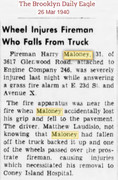
__________________________________
The General Order placing Engine 46 and Ladder 17 in service with the Brooklyn Fire Department.
Headquarters Department of Fire 365 and 367 JAY STREET,
GENERAL ORDER No. 7, NINTH SERIES.
I. On and after 8 o'clock, A. M., December 9th, 1895, this department will organize and place in service Engine Companies Numbers 44, 45, 46 and 54, and Hook and Ladder Companies Numbers
16 and 17, in the 31st Ward, late Town of Gravesend.
II. The signal 2-4-3 "there is a fire in station No.--- annexed district," preceded by the signal 2-2 and followed by the station number, will be used to notify the department of all first alarm fires in said annexed district. In case of a second or third alarm call, the requisite number of strokes will precede the station number.
III. Company commanders will be guided by the "Second Series" of the running card book, in regard to the station and assignments for duty in the annexed district.
By order of
CHESTER B. LAWRENCE
Commissioner
____________________________________
The Special Order relocated Engine 146 into new quarters and made it a double company:
FIRE DEPARTMENT, CITY OF NEW YORK BOROUGH OF BROOKLYN AND QUEENS
SPECIAL ORDER NO 133 NEW YORK CITY, DECEMBER 20, 1904
I) By direction of the Fire Commissioner, Engine Co. No. 145, located in West 8th Street, near Surf Avenue, Borough of Brooklyn, is hereby Re-organized as a double engine company (and will locate in the new quarters adjoining present premises), to take effect from and after 8 o'clock A. M., December 22, 1904.
II) Engine Co. No. 146 at the same time and date will locate in their new quarters on the east side of East 23rd Street, near Voorhees Avenue, Borough of Brooklyn, and to be Re-organized as
a double engine company with the addition OF a combination Hook & Ladder truck.
By Order of,
EDWARD F. CROKER
CHIEF OF DEPARTMENT
____________________________________
Department Order placing Ladder 169 in service in 1929:
HEADQUARTERS FIRE DEPARTMENT CITY OF NEW YORK
GENERAL ORDER NO 59 NEW YORK, October 16, 1929
I By direction of the Fire Commissioner the following is directed, made and promulgated to take effect at 9 A. M., October 18, 1929:
Hook and Ladder Company 169 organized, located at No 2731 East Twenty-Third Street, Sheepshead Bay, Brooklyn, equipped with a 75 foot American LaFrance Hook and Ladder Truck, and Assigned to the 43rd Battalion, 12th Division.
Engine Company No. 246 is discontinued as a Double Combination Company and reorganized as a Double Engine Company, equipped with two 2nd Size American LaFrance Gasoline Propelled and Pumping Engine Hose Wagons (single units), and a Mack Auto Chemical and Hose Wagon, and Assigned as at present.
By Order of the Fire Commissioner
Joseph B. Martin,
Assistant Chief of Department.
- - - - - - - - - - - - - - - - - - - - - - -
The first members assigned to Ladder 169.
Lieutenant:
Joseph A. Morrissey, Engine 246
James A. Molloy, Engine 246
Firemen 1st grade:
Peter J. Groom, (Chauffeur) Engine 246
Edward G. Gilcher, " Engine 246
Francis J. Dowling, " H.&L. 105
Thomas H. McQuillan, " " 109
Joseph E. Flatley, Engine 246 William M. Walsh, Engine 246
Thomas S. Curley, " 246 Frank Gallagher (2), " 246
Marion McGibney, " 246 William Klinck, H.& L. 102
____________________________________
Department Order disbanding Engine 327 and moving Engine 246 and Ladder 169 into new quarters:
FIRE DEPARTMENT CITY OF NEW YORK UNIFORMED FORCE
DEPARTMENT ORDER NO. 128 July 7, 1960
2.1 DISCONTINUANCE OF ENGINE CO. 327
Effective 9 A. M. on July 16, 1960, the operations of Engine Co. 327, located at 2731 East 23rd Street, Brooklyn, shall be discounted as a fire fighting unit. The following procedures shall govern such discontinuance:
(a) The transfer of officers and fireman presently assigned to Engine Co. 327, shall be promulgated on Department order.
(b) The disposition of apparatus and equipment assigned to Engine Co. 327 shall be under the direction and control of the officer in command of the Division of Repairs and Transportation.
(c) The necessary changes of administrative districts and assignments shall be promulgated on Department Order Supplement.
(d) The packaging, marking, storage and/or redistribution of all records of Engine Co. 327, shall be under the direction and control of the Division Commander, 12th Division.
(e) The disposition of department property, other than apparatus and fire fighting equipment, assigned to Engine 327, shall be under the direction and control of Bureau of Accounts and Procurement.
2.2 RELOCATION OF ENGINE 246 & LADDER 169
Effective 9 A. M. on July 16, 1960, the operational and administrave activities of Engine Co. 246 and Ladder Co.169, shall be transferred from 2731 East 23rd Street, Brooklyn, to 2732 East 11th Street, Brooklyn
____________________________________
THE APPARATUS OF ENGINE 246 & LADDER 169:
*1893 Silsby 4th size (300-500 gpm) steamer #2243 from the Town of Gravesend
*1899 LaFrance 3rd size (500-700 gpm) steamer #415
*1883 Amoskeag 2nd size (700-800 gpm) steamer #585 received 1909 after rebuilt
*1891 Amoskeag 2nd size (700-800 gpm) steamer #669 received 1910 rebuilt in 1899
1921 American LaFrance 700 gpm #3571
1938 Ahrens Fox 1000 gpm #3441 went to Engine 253
1951 Ward LaFrance 750 gpm #2602 went to Eng. 32 as hose wagon
1958 Mack 750 gpm #1059 from Eng. 327 7-16-1960
1969 Mack 1000 gpm #MP6902 from Eng. 222 in 1972
1970 Mack 1000 gpm #MP7009 from Eng. 23 in 1976
1979 Mack 1000 gpm #MP7950
1987 Mack 1000 gpm #MP8717
ENGINE 246 2nd section:
*1893 LaFrance 2nd size (700-800 gpm) steamer #277 to Eng. 253
1905 W S Nott/Christie 2nd size (700-800 gpm) steamer #616 front drive tractor in 1920
1920 American LaFrance 700 gpm #2991 from Eng. 76 in 1925
1931 American LaFrance 700 gpm #7341 received 12-26-1930
ENGINE 327
1931 American LaFrance 700 gpm #7341 from Eng. 246 (2)
1938 Aheren Fox 1000 gpm #3424 from Eng. 23 8-21-48
1958 Mack 750 gpm #1059 to Eng. 246 7-16-1960
HOSE WAGONS:
*1895 P. J. Barrett 2nd size
*1892 P. J. Barrett 1st size assigned to 2nd section in 1905
1922 Mack/Boyd 12-16-1922 - 10-11-1930
1928 FWD/Pirsch from Eng. 19
LADDER 169:
(Units assigned to (in order) Ladder 17, Engine 46, Engine 146, Engine 246)
*1896 Gleason & Bailey 50' aerial #5B
*1910 Seagrave 50' aerial w/ Chemical tank #4229
1921 Pirsch/White combination Chemical & City Service #202
(Units assigned to Ladder 169)
1924 American LaFrance 75' aerial #227 from Lad. 123 10-18-1929
1928 American LaFrance 75' aerial #273 used
1938 FWD 85' aerial #329 from Lad. 16 went to Lad. 174 with 1948 Ward LaFrance tractor
1940 Ahrens Fox 85' aerial #342 from Lad. 125 with 1948 Ward LaFrance tractor pulling it
1955 FWD 75' aerial #393 from Lad. 166 in 5-1968
1972 Seagrave 100' rear mount #SL7216
1980 Seagrave 100' rear mount #SL8017 in 1981
1988 Seagrave 100' rear mount #SL8801
* horse drawn units
HOUSE LOCATIONS:
2728 E. 23rd Street Between: Shore Parkway & Voorhies Avenue Faces: East
____________________________________
HISTORY
SHEEPSHEAD BAY VOLUNTEER FIRE DEPARTMENT:
ENGINE 1 1889 - December 9, 1895
LADDER 1 Feb. 1889 - December 9, 1895
HOSE 1 1889 - December 9, 1895
HAND ENGINE 1 1889 - December 9, 1895
BROOKLYN FIRE DEPARTMENT:
ENGINE 46 December 9, 1895 - January 28, 1898
LADDER 17 December 9, 1895 - January 28, 1898
NEW YORK CITY FIRE DEPARTMENT (F.D.N.Y.)
ENGINE 46 January 28, 1898 - April 15, 1898
LADDER 17 January 28, 1898 - April 15, 1898
COMB. ENGINE 46 April 15, 1898 - October 1, 1899
COMB. ENGINE 146 Oct. 1, 1899 - December 22, 1904 2731 E. 23rd STREET Between: Shore Parkway & Voorhies Avenue Faces: West
HISTORY:
COMB. ENGINE 146 December 22, 1904 - January 1, 1913
ENGINE 146 (2) December 22, 1904 - January 1, 1913
COMB. ENGINE 246 January 1, 1913 - October 18, 1929
ENGINE 246 (2) January 1, 1913 - August 16, 1939
ENGINE 246 October 18, 1929 - July 16, 1960
ENGINE 327 August 16, 1939 - July 16, 1960
LADDER 169 October 18, 1929 - July 16, 1960
RELAY HOSE WAGON 105 December 26, 1942 - May 15, 1945
____________________________________
Engine 246/Ladder 169 Firehouse 2732 East 11th Street Brighton Beach, Brooklyn
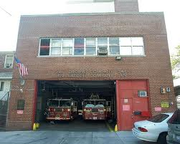
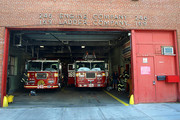
____________________________________


